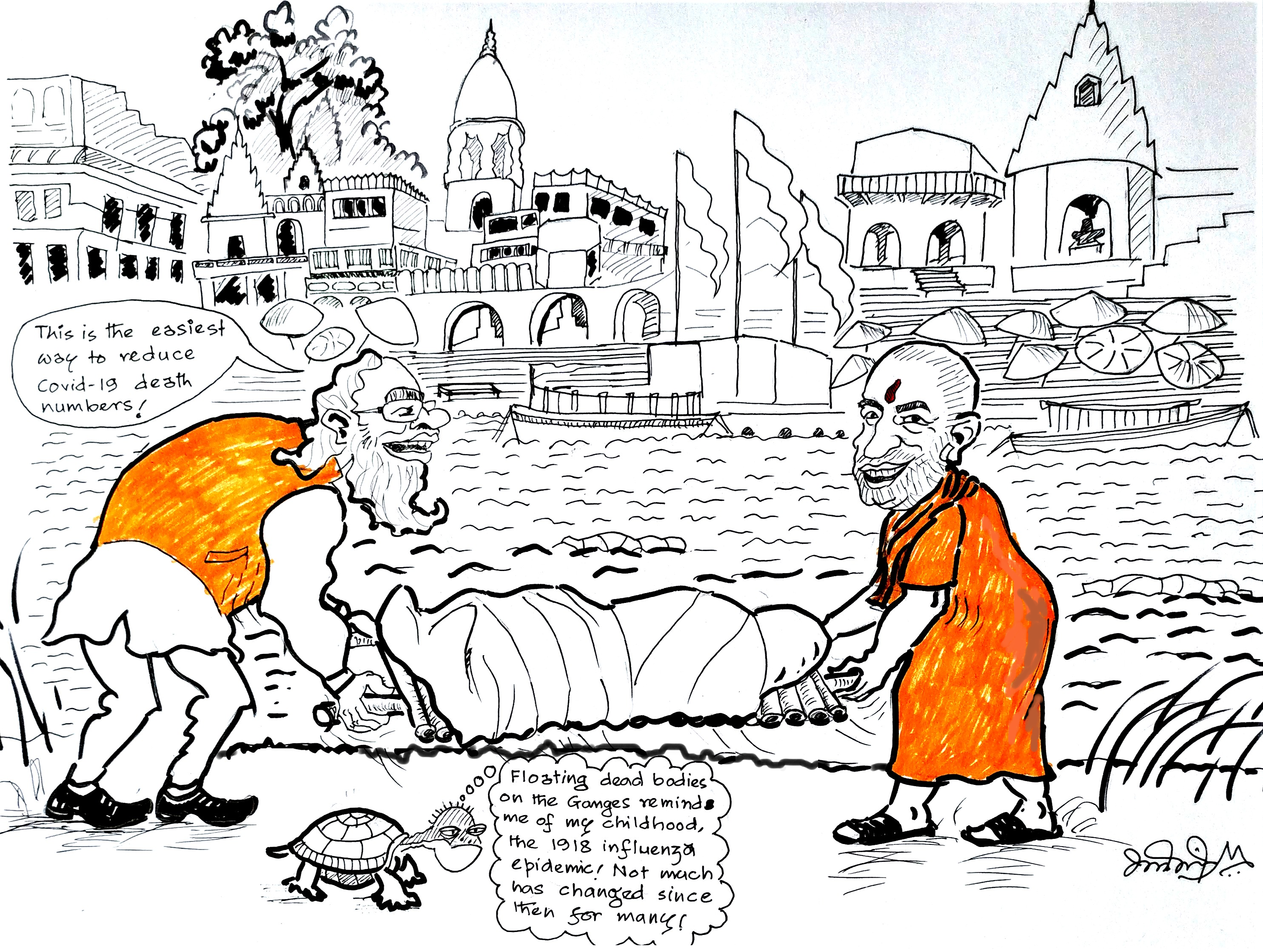Santosh Verma and Tripti Kumari

The spread of COVID-19 and the subsequent lockdowns in India since the last week of March 2020 have put not just people’s health concerns at the forefront, but most of the economic and social sector activities are at halt. Amidst the virus spread and subsequent lockdowns, schools, colleges, universities (educational institutions) are closed without completing the academic calendar year. To deliberate on teaching and learning processes and research activities in these educational institutions particularly in higher studies during the lockdowns and provide contemplating measures, the University Grants Commission (UGC) constituted an Expert Committee in April 2020. One among the various concerns before the Committee was to evolve a method to complete the teaching and learning process in the current year/semester. The committee found that most of the universities and affiliated colleges had covered 60 to 70 percent teaching and learning processes for this year (UGC, 2020). The committee prescribed that the remaining teaching and learning processes (at least 25 percent) should be completed through online mode to comply with the norms of social distancing among the teachers, students and the staff in all the educational institutions (UGC, 2020. Taking a note of it, the Ministry of Human Resource and Development (MHRD) and the UGC issued various guidelines to ensure teaching and learning to impart online education among the students. The MHRD and the UGC emphasised that the educational institutes, particularly teachers, should use IT services and infrastructure for effective delivery of e-learning among students. The educational institutes were advised by the UGC that online education should be done using e-resources such as Google Classroom, Google Hangout, Cisco WebEx Meeting (video conferencing etc.), You Tube Streaming, Open Educational Resources (OERs), SWAYAM Platform and SWAYAMPRABHA (available on Doordarshan (Free dish) and Dish TV), WhatsApp Groups, Emails and other Social Media Tools, etc. (UGC, 2020).
This article tries to understand the status, effectiveness and inclusiveness of these online classes conducted by the universities fulfilling the guidelines of the UGC with the perspective of university students. The students were surveyed using google questionnaire to collect information regarding the online classes. The students who took part in the survey belonged to both central and state universities where online classes were being run by the university faculties. A total of 852 students took part in the survey. Half of the students who took part in the survey belonged to central universities such as Delhi University (41.4 percent) and Allahabad University (9.4 percent and other half belong to state universities like Ambedkar University Delhi (3.5 percent), Himachal University (5.3 percent), Bhimrao Ambedkar Bihar University, Muzaffarpur, Bihar (24.6 percent), Lalit Narayan Mithila University, Darbhanga, Bihar (7.6 percent), and Jammu University, Jammu (8.2 percent).
A Social Profile of the Students
Of the total surveyed students, 58 percent belonged to the General category, 31 percent belonged to other backward category, 8 percent belonged to Scheduled Castes (SCs) and 3 percent belonged to the Scheduled Tribes category.
Figure 1: Social Profile of the Students
 Source: Authors’ calculation from the primary data.
Source: Authors’ calculation from the primary data.
A Detailed Analysis
After receiving circulars from the UGC to conduct online classes for students, most of the universities asked their faculty to abide by these norms. But, There was hardly any university which conducted feasibility study to find whether there are infrastructure available for online classes, condition of IT services, availability of computers and laptops with the students, availability of internet facility such as LAN, WIFI and Mobile Internet with the students. The universities also didn’t bother to find how the online classes could make students economically, physically and psychologically vulnerable. There were various other marginalities which students faced such as their rural location where there was weak connectivity of internet services, students coming from weaker sections who didn’t have access to mobiles, computers and laptops, but everyone was supposed to attend and follow the online classes.
During the survey, we asked whether they have been informed about online classes by their university or faculty, 85.4 percent of the total students said that they were informed and registered for the same where as 14.6 percent students were not aware of online classes. Of the total registered students for online classes, only 9.6 percent students were attending their online classes on their own computers/laptops and the rest 90.4 percent were attending using mobile phones. Students who were using mobile phones, around 73.9 percent were having their own mobile, 11.5 percent were using their parent’s mobile, 1.6 percent were using friend’s or neighbour’s mobile and 3.4 percent were using some other family members’ mobile to attend the online classes.
The social category-wise stratification shows that among the general students, around 13.9 percent were using computers to attend their online classes where as 86.1 percent were using mobile phones for the same. The proportion of students using mobile phones to attend the online classes were higher among OBCs (96.6 percent), SCs (96 percent) and STs (100 percent) (Refer Table 1). A higher proportion of students attending online classes using mobile phones show fragility of IT infrastructure as far as teaching and learning processes are concerned. Many students claimed that there is no consistency in their online studies, as teachers conducted the classes based on their own comfort. The irregularity of these classes, fragility of e-resources and use of mobile phones for longer hours pushed them into physical and mental stress.
Table 1: Sources through which Students are Connected to Online class (in Percent)
 Source: Authors’ calculation from the primary data.
Source: Authors’ calculation from the primary data.
As discussed above, most of the students were using mobile phones to attend the online classes. The Table 2 shows around 69.2 percent students were using own mobile internet data and 9.1 percent were using hotspot data from other’s mobile. So, a total of 78.3 percent students were using mobile internet networks to access online classes and download materials uploaded by their teachers. Use of mobile data network was even higher among the students belonging to OBCs, SCs and STs categories in comparison to general category students who had higher proportion (30.7 percent) availing WIFI networks to access online classes. (refer Table 2).
Table 2: Medium of Internet Connectivity in Online Class

When asked whether students were regularly involved in online classes, around 54.2 percent of them said, yes, they attended it regularly whereas 45.8 percent students said that they did not attend it regularly (refer Figure 2).Source: Authors’ calculation from the primary data.
Figure 2: Regular Involvement in Online classes

Source: Authors’ calculation from the primary data.
Of those students who did not attend the online classes regularly, when asked to give reasons for the same, around 7.8 percent said they felt lesser interest in such classes, around 17 percent said they found it difficult to get clarity from the online classes, half of these students who were not attending regular classes said that due to problem in internet data speed, they were not regular in these classes. The limitation of internet data was also one of the reasons for the students (around 23.3 percent) to not being regular during the class (refer Table 3).
Table 3: Reasons for not being Regular in Online classes

On asking whether the reading materials uploaded using different e-resources or mailed to students were sufficient, around 57.4 percent students agreed that materials were sufficient whereas around 42.6 percent students said the reading materials were insufficient (refer Figure 3). Some of the students claimed that either no reading materials were being provided or were insufficient or were not readable. In some of the state universities, students claimed that teachers were uploading scanned copy of hand written materials, which they couldn’t even read. Some students of the Delhi University and the Ambedkar University Delhi said that only Power Point documents are being provided as reading materials. Students also claimed that sometimes teachers uploaded a whole book and their size was too big to download from a mobile data network. As mentioned, most of the students were using mobile phones – to attend the online classes, to download and to read the materials uploaded by the teachers, it made difficult for the students to read and grasp 50 – 60 pages and sometimes even more in a day. The students had to comply with at least 4 to 5 such online classes every day and that too not in a planned way. Most of the students studying subjects like economics and natural sciences also claimed that understanding concepts, graphs and equations were very difficult through online classes. The state university students claimed that most of the materials uploaded were in English language and they found it difficult to grasp as their medium of study was not in English.
Figure 3: Reading Materials – Sufficient or Insufficient
 Source: Authors’ calculation from the primary data.
Source: Authors’ calculation from the primary data.
Facing these difficulties, around 83 percent of the total students who took part in google survey said that online classes cannot be the substitute of face to face teaching and learning in the class rooms whereas 17 percent students said that they liked the online classes, but these should be more organised and planned, for example, some students said that there was no time fixed for a class and teachers conducted these classes whenever they felt comfortable for themselves. Even in these circumstances, if the students tried to follow the online classes, they faced problems of mobile internet speed, data limits and electricity problems that made it difficult for them to do so.
Concluding Remarks
The spread of COVID-19 and the subsequent lockdowns led UGC to issue guidelines to the universities in India to complete remaining portions of teachings through online classes using e-resources. But, these guidelines were enforced on universities without taking a view of weak IT infrastructure, especially, in the state universities. Most of the students used their mobile phones to attend the online classes, download the materials and to read them which a major proportion of students said were not worth at all. These online classes were enforced on students without giving reasonable thought of their rural-urban divide, availability of computers/laptops with them, internet facilities and the social and economic backwardness of the students. These online study programmes enforced by the UGC and conducted half-heartedly by the universities, during the spread of COVID-19 and the subsequent lockdowns, imparted students more stress and headache than the knowledge.
Santosh Verma is Independent Researcher and Tripti Kumari is Assistant Professor, Dr. B.R. Ambedkar Bihar University, Muzaffarpur
References
University Grants Commission (2020): UGC Guidelines on Examinations and Academic Calendar for the Universities in View of COVID-19 Pandemic and Subsequent Lockdown, UGC, April. Available at https://www.ugc.ac.in/pdfnews/4276446_UGC-Guidelines-on-Examinations-and-Academic-Calendar.pdf.


